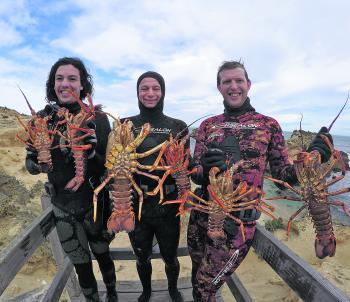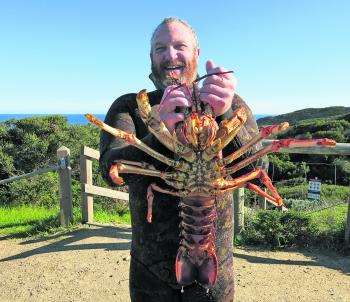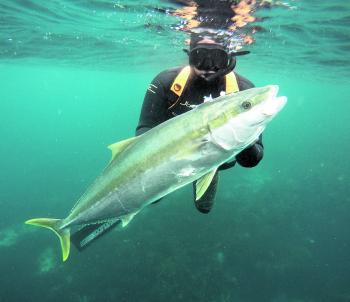December at last! Summer is here, and Christmas breaks loom. Good weather be gifted to all! We hope… Let’s face it, we’re coming off one of the worst spells of weather in living memory. It’s time for a change for the better.
The crays are on, and abalone are back on the take list for central Victoria. We are at the tail end of what has been a stellar squid season, and it is still not quite over.
Large trevally have been abundant from the South Australian border right through to Wilsons Promontory, and large shoals of big salmon are still surprising divers with their high speed and fleeting visits.
Some larger than normal snapper have been speared in the northern reaches of Port Phillip Bay, which is exciting news.
All this, plus a great warming of both the water and air. How can it get better?
One word. Kingfish. The yellowtail kingfish is the Victorian diver’s dream capture. We are not overly blessed with visitations from large pelagic species, so when the weather warms and the heavens align, all thoughts are focussed on this single majestic creature.
Most of the fish captured in Victoria will be in the 8-15kg size range, with some exceptions at either end of the scale. The state record is 23kg and the minimum legal size is 60cm. Small guns can be put away, it’s time to dust off the 110s, 120s and 130s. Time to break out a larger float or a reel. Time to scratch around the shed to try and locate the flashers, unseen since the end of autumn.
Kingfish go hard, and generally, they go down. Kingfish will smash your gear if given a chance, and it’s because of this that they are the most fun a Victorian spearo can have! Make sure that your spear is sharp, your rubbers pristine and, most importantly, ensure that your shooting line is up to the task. Minimum requirement is 400lb mono, although I prefer 2mm Spectra as a shooting line. Spectra will not break or kink when being thrashed, bashed and crashed through the reef, thus improving your chances of landing the fish should the shot be a little off.
Aim for the head or lateral line and try to either brain it or damage the spine. A poorly shot fish will test your stamina as well as your equipment.
If kingfish are in the area, they will usually be attracted to noise, vibration and flashers. Flashers work well when the sun is shining. It seems that one of the best ways to attract kingies is to shoot something else. It is amazing how often this happens. Imagine flashing unsuccessfully for hours on end with no result, so you decide to shoot something else for the sake of the esky. A school of kings may roll on through to check out the commotion. They loll around, nonchalantly, while you frantically try to reload your gun. Only, as you pull the rubber back toward the notch, will the whole school casually swim off into the distance. This is what make these fish such a fun and challenging fish to target.
There are ways to maximise your success. Make sure that your equipment is in fine order, and be prepared to spend the entire day in the water. The key is to not give up. Go to a recognised location, one where kings have regularly been speared in the past, or where they have recently been seen. Try to pick up intel wherever you can. Regular hotspots for kings include the Northshore at Portland, Lady Julia Percy Island west of Port Fairy, Kennett River, Charlemont Reef, Point Lonsdale, The Rip, Mornington, Cape Schanck, Pyramid Rock, Cape Woolamai, Cape Liptrap, Great Glennie Island and Gabo Island.
Many of these locations are not for the fainthearted, nor are some of them suitable for the inexperienced. Be careful, be aware and make sure that you come home safely. No fish is worth a life.
Have fun this month!
Reads: 4287
Joel, Nick and Nathan with some Mornington Peninsula lobster.

A small rat king to kick off the season.

Nathan, Murray and Paul hold up their kings. This is what summer spearing is all about!

The author looks stoked with this fine specimen from Koonya.

The author nailed this Great Glennie Island king recently.




